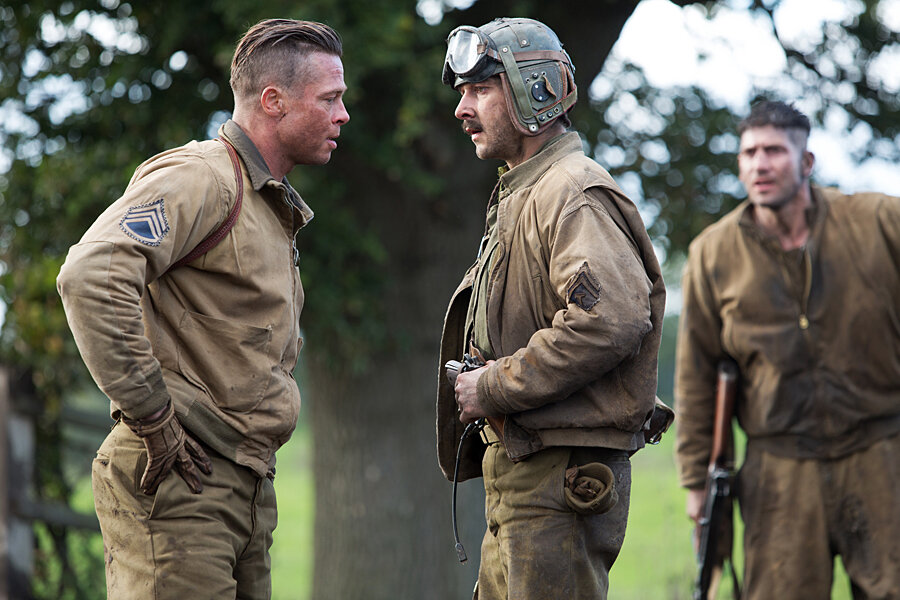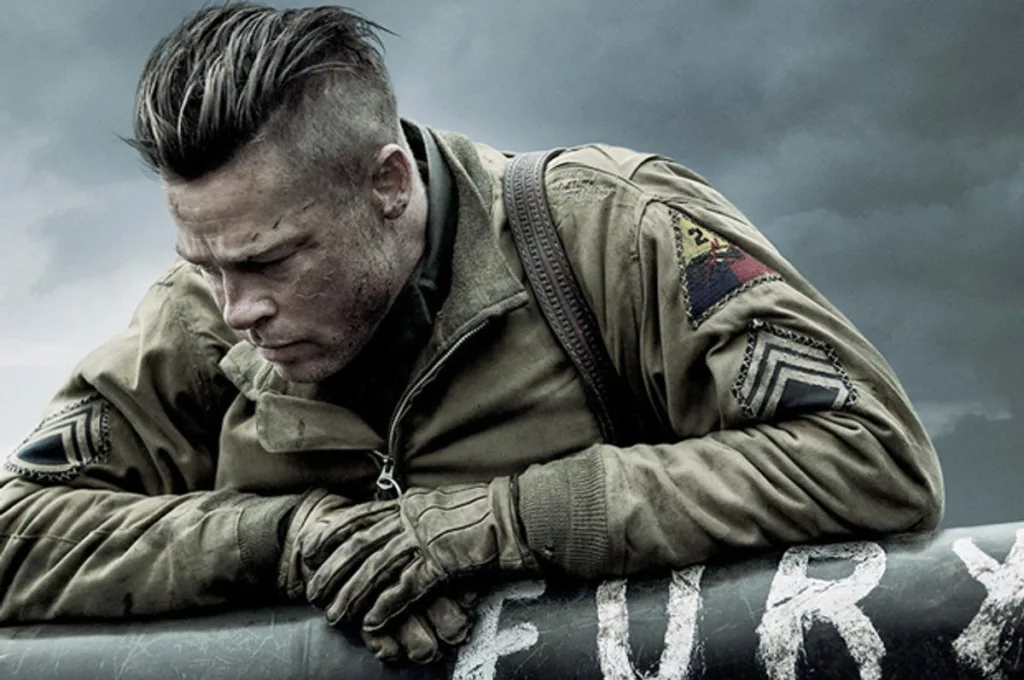Fury is a 2014 war film written and directed by David Ayer. Starring Brad Pitt, the film is set during the last months of World War II in April 1945. The film follows the story of a five-man crew of an M4A3E8 Sherman tank named Fury, commanded by Don “Wardaddy” Collier (Brad Pitt), as they embark on a deadly mission behind enemy lines. The film received critical acclaim for its intense and realistic depiction of the horrors of war.
But is Fury based on a true story? The answer is somewhat complicated. While the events depicted in the film are fictional, the film is based on a collection of true stories from real-life army veterans who spent their time during World War II in tanks, just like Pitt’s tank crew in the film.
The 3rd Armored Division, to which the crew of Fury belongs, landed in Normandy on June 24, 1944, with years of training but no combat experience. Over the next 11 months, the division would be part of the fiercest fighting in Europe during World War II. The film depicts the harsh reality of war that thse soldiers faced, from the brutality of enemy combatants to the psychological toll that it took on them.
One of the most controversial scenes in the film involves the execution of German citizens by the SS for wanting to surrender. This scene is historically accurate, particularly in Western Germany, when the Allied forces were advancing rapidly after crossing the Rhine River on March 7, 1945. The SS was known for their brutal tactics and their willingness to execute civilians who they suspected of being traitors.
The tanks used in the film, both the Sherman M4A3E8 and the Tiger 131, are real and belong to the Tank Museum in Bovington, England. The filmmakers went to great lengths to ensure that the tanks were as accurate as possible, even going so far as to hire tank experts to guide the actors on how to operate the tanks realistically.
Fury is a gripping and intense war film that depicts the harsh realities of combat during World War II. While the events depicted in the film are fictional, they are based on real-life experiences of soldiers who fought in the war. The film offers a powerful reminder of the sacrifices made by these soldiers and the horrors of war that they faced.
The Reality of the Fury Tank in World War II
Fury, the tank featured in the 2014 film of the same name, was not a real tank used in World War II. However, the tanks used in the film were real and historically accurate. The Sherman M4A3E8 and the Tiger 131 are both real tanks that were used durig the war. They are currently housed in the Tank Museum in Bovington, England.
The Sherman M4A3E8, also known as the Easy Eight, was a variant of the M4 Sherman tank that was introduced in 1944. It was produced in large numbers and saw action in several major battles of the war, including the Battle of the Bulge and the Rhine crossings. The Easy Eight had various improvements over earlier models, including a more powerful engine, wider tracks, and improved suspension.
The Tiger 131 was a German heavy tank that saw action on the Eastern Front and in North Africa during the war. It was captured by British forces in Tunisia in 1943 and is the only surviving example of a Tiger I tank that is still operational. The tank was restored to running condition in the 1990s and is now a popular attraction at the Tank Museum.
While Fury was not a real tank used in World War II, the tanks featured in the film were historically accurate and important pieces of military history. The use of real tanks in the film helped to bring a sense of authenticity to the story and provided an opportunity for audiences to learn more about these legendary vehicles.

Factual Accuracy of ‘Fury’
Fury, the 2014 action film directed by David Ayer and starring Brad Pitt, is based on a collection of true stories from real-life army veterans who served in tanks during World War II. While the film is a work of fiction, it is grounded in historical accuracy and draws on the experiences of those who fought in the war.
Here are some of the true events and elements that inspired Fury:
1. Tank warfare: The film’s depiction of tank warfare is based on the real-life experiences of veterans who served in tanks during World War II. The tank crew in the film, led by Pitt’s character, is shown engaging in battles and navigating through dangerous terrain, all of which are based on real-life events.
2. The Battle of Cologne: The film’s climactic battle takes place in the German city of Cologne, which was a major target for Allied forces during the war. While the specifics of the battle depicted in the film may not be entirely accurate, the general setting and historical context are based on real events.
3. Tank crew dynamics: The relationships between the members of the tank crew in Fury are based on the real-life dynamics that ofen developed between soldiers who served together in close quarters for extended periods of time.
4. Military uniforms and equipment: The film’s attention to detail in its depiction of military uniforms and equipment is based on extensive research and consultation with military historians and veterans.
While Fury is a work of fiction, it draws on real-life experiences and events to create a compelling and historically accurate depiction of tank warfare during World War II.
The Real-Life Battle Inspiration Behind ‘Fury’
The movie Fury is based on the Battle of Cologne, which took place in March of 1945. The battle was part of the larger Allied offensive kown as the Rhineland Campaign, which aimed to cross the Rhine River and push deeper into Germany. The Battle of Cologne was particularly intense, as German forces fought fiercely to defend the city. The 3rd Armored Division, which the main characters in Fury are part of, played a crucial role in the battle and helped to capture the city. The division suffered heavy casualties, but their efforts were instrumental in securing a key victory for the Allied forces.
The Historical Accuracy of ‘Fury’
Fury (2014) is a movie set during the final days of World War II, following the story of a tank crew in Germany. The movie depicts scenes of German citizens being executed by the SS for wanting to surrender, and the question arises as to whether this is historically accurate.
The answer is yes, particularly in Western Germany during the final months of the war. As the Allied forces were advancing rapidly after crossing the Rhine River on March 7, 1945, the German army was in retreat and the civilian population was caught in the middle of the fighting. The German High Command had issued orders to fight until the bitter end, and those who chose to surrender were seen as traitors to the cause.
The SS, in particular, had a reputation for brutality and were known for executing civilians who were suspected of being sympathetic to the Allies. In some cases, they woud even execute German soldiers who had been captured by the Allies and later released.
The movie also depicts scenes of tank battles and close-quarter combat, which are generally accurate in terms of the tactics and equipment used by both the Germans and the Allies during the war. The tank crew’s Sherman tank, named Fury, is shown as being outmatched by the German Tiger tanks, which were indeed superior in terms of armor and firepower.
However, it should be noted that the movie takes some liberties with historical accuracy, such as the portrayal of the tank crew’s mission to hold a crossroads against overwhelming odds. In reality, such a mission would have been highly unlikely, as tanks were generally used in support of infantry and were not sent on solo missions.
While Fury takes some liberties with historical accuracy, it does accurately depict the brutal nature of the war in its final days, including the execution of German civilians by the SS for wanting to surrender. The movie also accurately portrays the tactics and equipment used by both sides during the war, although some aspects are exaggerated for dramatic effect.

Conclusion
Fury is a remarkable and accurate portrayal of the brutal realities of tank warfare dring World War II. The film’s attention to historical detail, from the use of real tanks to the depiction of wartime atrocities, is a testament to the filmmakers’ dedication to authenticity. The cast’s powerful performances, particularly Brad Pitt’s portrayal of the hardened tank commander, add to the film’s emotional impact. Fury is a must-see for anyone interested in the history of World War II or the evolution of modern warfare. It is a film that will stay with audiences long after the credits roll, and a fitting tribute to the brave soldiers who fought and died in the war.
